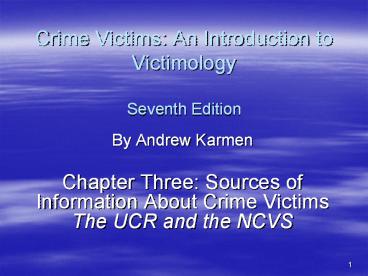Crime Victims: An Introduction to Victimology Seventh Edition - PowerPoint PPT Presentation
Title:
Crime Victims: An Introduction to Victimology Seventh Edition
Description:
Crime Victims: An Introduction to Victimology Seventh Edition By Andrew Karmen Chapter Three: Sources of Information About Crime Victims The UCR and the NCVS – PowerPoint PPT presentation
Number of Views:608
Avg rating:3.0/5.0
Title: Crime Victims: An Introduction to Victimology Seventh Edition
1
Crime Victims An Introduction to
VictimologySeventh Edition
- By Andrew Karmen
- Chapter Three Sources of Information About Crime
Victims The UCR and the NCVS
2
Introduction
- The Big Picture
- When and where do crimes occur?
- How often are weapons used?
- Are victims usually strangers?
- Do victims resist? Should they?
- How often are victims injured?
- What do victims lose?
3
Introduction
- How do we put together the Big Picture?
- Official statistics gathered by government
- Criminologists and victimologists gather their
own data - Special interest groups gather crime data
4
Use and Abuse of Statistics
- Statisticsmeaningful numbers that reveal
important information - Official statisticscompiled and published by
government - Statistics
- Provide realistic assessments of a threat posed
to individuals by criminal activity - Reveal patterns of criminal activity
- Reflect trends in criminal activity
5
Use and Abuse of Statistics
- Statistics continued
- Reveal costs and losses by criminal activity
- Project number of possible victims of a
particular crime - Evaluate effectiveness of recovery efforts and
prevention strategies - Identify statistical portraits (profiles) of a
typical victim
6
Use and Abuse of Statistics
- Interpretation of Statistics
- Can be used to influence decision makers
- Can be used to reduce fears
- Can be used to support police administration
- Can be used to show something is not working
7
Caution
- However, be aware that statistics can be used to
present one viewpoint, or be presented with a
spin.
8
Uniform Crime Report (UCR)
- FBI gathers data from local police departments
and publishes an annual report of crime
statistics called the Uniform Crime Report (UCR) - Part One Crimes Reported8 Crimes
- Violent Crime Data(4) Murder, Forcible Rape,
Robbery and Aggravated Assault - Property Crime Data(4) Burglary, Larceny/Theft,
Motor Vehicle Theft and Arson
9
Uniform Crime Report (UCR)
- One method of illustrating the UCR data is the
Crime Clock, which shows how many seconds or
minutes apart a particular crime or criminal
event occurssee Figure 3.1, Page 55
10
Uniform Crime Report (UCR)
- UCR reflects data for cities, counties and states
- Reports include
- Number of complaints filed with police
- Proportion of cases solved
- Characteristics of offenders arrested
11
Uniform Crime Report (UCR)
- Shortcomings of UCR Report
- Underreporting a major problem
- Focus is offenders, not victims (homicide
exception) - Mixes attempted crimes and completed crimes
- Robbery includes all targets, does not single out
households, banks, stores, etc. - Uses hierarchy rule, which reports only the
most serious crime in a sequence of several
criminal incidents
12
National Incident-Based Reporting System (NIBRS)
- Tracks 46 Group A OffensesGreater Breakdown in
data - i.e. simple assault, vandalism, blackmail, fraud,
statutory rape, kidnapping - Gathers data relating to commission of crime,
victim information, value of theft,
race/ethnicity - Originally scheduled for year 2000 implementation
13
The NCVS
- Another set of data is collected by the Bureau of
Justice Statistics and is based on surveys with
victims. It is called the National Crime
Victimization Survey (NCVS) and it often paints a
different picture than the UCR
14
National Crime Victimization Survey(NCVS)
- Crime rates determined by public survey randomly
selected by U. S. Census Bureau - First survey, 1966Presidents Commission on Law
Enforcement and the Administration of Justice - The NCVS reports crimes in the form of rates per
1000
15
National Crime Victim Survey(NCVS)
- Crimes studied
- Forcible rape sexual assault
- Robbery
- Aggravated assault simple assault
- Theft
- Household burglaries
- Motor vehicle thefts
- Only surveys those 12 years of age or olderDoes
NOT include crimes against those under 12 years
of age
16
Four Reasons NCVS Questioned
- Bias of Information
- Credibility of Information
- Wives reporting abuse, girls reporting date rape,
boys reporting robberies on bad drug deals - Crimes against children under 12 not probed
- Over reporting
- Pollsters, not detectives, to sort out
conflicting stories or facts
17
Estimated Victimization Rates
- Table 3.1, Pages 65-66
- Crime rates reported by NCVS UCR for 2006
presented
18
UCR vs. NCVS
- During 70s and 80s, there appeared to be low
correlation between the two official sources of
data in regards to victimization rates - The two reporting systems again gave conflicting
signals at the end of 2001 regarding violent
crimes and property crimes
19
UCR vs. NCVS
- UCRNo data for victims except murder
- NCVSNo data on crimes of murder, bias/hate
crimes, line of duty assaults on police - No data on offenses against children under 12
- No data on business robberies or burglaries
- No data on arson or victims of arson
- UCRcomputes rates/100,000 population
- NCVScomputes rates/1,000 age 12 and older
or/households (no number)
20
Key Terms
Statistics Official Statistics Patterns
Trends Profiles Spin
Crime Clock Uniform Crime Report National Crime Victimization Survey
Correlation Index crimes Hierarchy Rule
Self report survey Memory decay Forward telescoping
Range (Confidence Interval) Victimization Rates Raw numbers
Big Picture Rates































